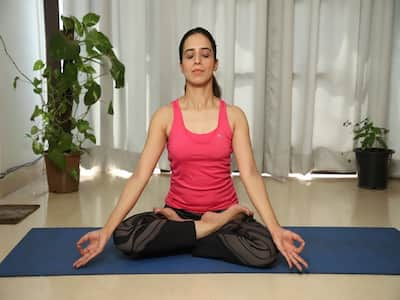
Yoga practitioner Bhushan Bhukte shares a step-by-step guide for performing padmasana.
Padma means ‘lotus’, and asana means ‘posture’ in Sanskrit. The lotus symbol is immediately associated with Yoga, whether on your yoga mat, ornaments or tattoos. What is the symbolism of the lotus? The flower itself is quite beautiful, with rows of petals and a yellow heart that seems full of light. The lotus flower symbolises the capacity to elevate yourself from the murky waters of life and turn yourself to the higher purpose of life, receiving grace from above. The lotus is also used to represent the chakras, or centres of energy that are purified and blossom under yoga training, especially meditation. It is associated with compassion, purity and wisdom.
Meditation Posture
Padmasana is one of the four meditation postures in the Hatha Yoga Pradipika, along with Siddhasana, Bhadrasana and Simhasana. (Hatha yoga pradipika: 1:44) In Padmasana, the legs are folded towards the hips, making a stable base and an energy lock directing the prana towards higher centres. The spine is straight like the lotus allowing the breath to deepen and slow down and the prana to flow freely, inducing a meditation state. In padmasana, the body sits ready for meditation, firmly rooted, spine straight so that the attention can be diverted inwards without distraction allowing the blossoming of consciousness.
Yoga practitioner Bhushan Bhukte at Heartfulness Yoga Centre shares a step-by-step guide to padmasana.
READ RELATED: 10 Healthiest Fast-Food Meals for Weight Loss, According to RDs
How To Practice?
- Sit in Dandasana with hands beside the body.
- Bend the right knee, place your right foot on the left thigh and bend the left knee, place your left foot on the right thigh.
- Ensure that feet soles are turned upward and the heels close to the abdomen. Both legs are interlocked.
- Keep the spine erect, chin parallel to the floor, and shoulders relaxed.
- Place both hands on the thighs, with the palms facing up, and the index fingers and thumbs forming a ring in the chin mudra.
- Keep the head straight and the spine erect.
- Hold the position, maintaining normal breathing with body awareness.
- Release the left leg first, then the right leg. Relax here.
Benefits
- It helps to develop good posture and strengthens the back.
- It increases flexibility in the leg and opens the hips.
- It improves concentration and calms the mind.
- Meditative posture.
Precautions
Practice Ardha Padmasana, overlapping only one leg over the other, alternate the leg that overlaps and maintain the posture with the spine straight and at ease until you feel comfortable overlapping both legs.
Do not practice if you have hip or knee problems.
Total Wellness is now just a click away.
Follow us on
window.addEventListener(‘load’, (event) => {
// $(document).ready(function(){
$(‘#commentbtn’).on(“click”,function(){
(function(d, s, id) { var js, fjs = d.getElementsByTagName(s)[0]; if (d.getElementById(id)) return; js = d.createElement(s); js.id = id; js.src = “//connect.facebook.net/en_US/sdk.js#xfbml=1&version=v2.3”; fjs.parentNode.insertBefore(js, fjs);}(document, ‘script’, ‘facebook-jssdk’));
$(“.cmntbox”).toggle();
});
// });
});








